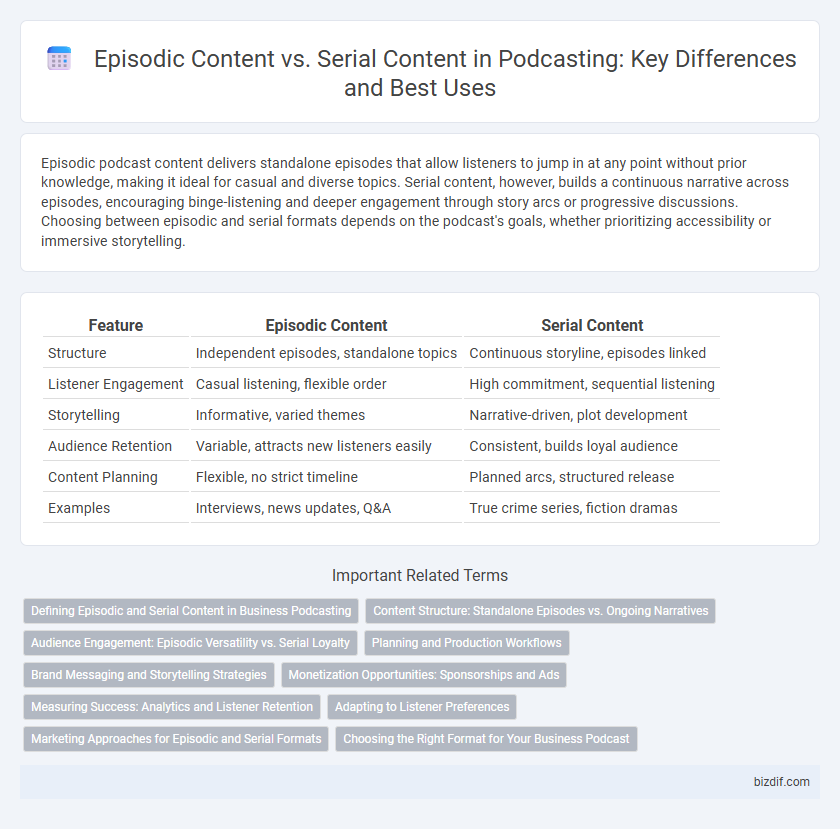Episodic podcast content delivers standalone episodes that allow listeners to jump in at any point without prior knowledge, making it ideal for casual and diverse topics. Serial content, however, builds a continuous narrative across episodes, encouraging binge-listening and deeper engagement through story arcs or progressive discussions. Choosing between episodic and serial formats depends on the podcast's goals, whether prioritizing accessibility or immersive storytelling.
Table of Comparison
| Feature | Episodic Content | Serial Content |
|---|---|---|
| Structure | Independent episodes, standalone topics | Continuous storyline, episodes linked |
| Listener Engagement | Casual listening, flexible order | High commitment, sequential listening |
| Storytelling | Informative, varied themes | Narrative-driven, plot development |
| Audience Retention | Variable, attracts new listeners easily | Consistent, builds loyal audience |
| Content Planning | Flexible, no strict timeline | Planned arcs, structured release |
| Examples | Interviews, news updates, Q&A | True crime series, fiction dramas |
Defining Episodic and Serial Content in Business Podcasting
Episodic content in business podcasting features standalone episodes that cover distinct topics, allowing listeners to engage with any episode independently without prior knowledge. Serial content, on the other hand, delivers a continuous narrative or theme across multiple episodes, encouraging sequential listening to follow developments or story arcs. Understanding the distinction between episodic and serial formats helps podcasters tailor their content strategy to audience preferences and engagement goals.
Content Structure: Standalone Episodes vs. Ongoing Narratives
Standalone podcast episodes offer listeners complete stories or discussions within a single installment, enabling easy entry and casual consumption without prior knowledge. Ongoing serial content relies on a continuous narrative or thematic progression, encouraging listener retention and deep engagement through character development or evolving topics across episodes. Effective content strategy balances episodic accessibility with serial consistency to maximize audience growth and loyalty in podcasting.
Audience Engagement: Episodic Versatility vs. Serial Loyalty
Episodic podcast content offers versatility, allowing listeners to engage with individual episodes without prior context, which attracts casual and new audiences. Serial content fosters deep narrative investment, building strong listener loyalty through continuing story arcs and character development. Balancing episodic variety with the sustained commitment of serial formats enhances overall audience engagement and retention.
Planning and Production Workflows
Episodic podcast content requires flexible planning workflows that prioritize standalone episodes with self-contained narratives, allowing for varied release schedules and minimal dependency between episodes. Serial content demands a tightly coordinated production workflow with detailed episode sequencing, consistent thematic development, and scripted continuity to maintain listener engagement across a continuous storyline. Efficient project management tools and collaboration platforms are essential in both workflows to streamline scripting, recording, editing, and distribution processes.
Brand Messaging and Storytelling Strategies
Episodic content in podcasting allows brands to deliver standalone messages, making each episode accessible and reinforcing key brand values without requiring audience continuity. Serial content fosters deeper storytelling by weaving a narrative across multiple episodes, enhancing emotional engagement and brand loyalty through sustained character development and plot progression. Strategic use of episodic versus serial formats depends on the desired brand impact, balancing immediate message clarity with long-term audience investment.
Monetization Opportunities: Sponsorships and Ads
Episodic podcast content attracts diverse sponsorships and ads due to its standalone nature, allowing brands to target specific episodes with relevant messaging. Serial content, with its ongoing storyline, offers longer engagement periods and premium ad placements, appealing to sponsors seeking deeper brand integration. Both formats optimize monetization by tailoring advertising strategies to listener habits and content structure.
Measuring Success: Analytics and Listener Retention
Measuring success in podcasting requires analyzing detailed analytics that track listener retention rates over time, distinguishing between episodic content with standalone episodes and serial content requiring sequential listening. Episodic podcasts often show fluctuating retention with peaks at individual episode releases, while serial podcasts depend on consistent engagement to maintain narrative continuity. Understanding listener drop-off points and completion rates helps creators tailor content strategies that maximize audience loyalty and growth within each format.
Adapting to Listener Preferences
Episodic content allows listeners to enjoy standalone episodes in any order, catering to those seeking flexibility and casual engagement. Serial content, with its continuous storyline, appeals to audiences who prefer a deeper, more immersive experience. Adapting podcast formats based on listener data and feedback can boost retention and listener satisfaction effectively.
Marketing Approaches for Episodic and Serial Formats
Episodic podcast formats enable flexible marketing strategies by targeting individual episodes based on specific topics, attracting diverse audience segments through tailored promotions and search engine optimization. Serial content marketing focuses on building sustained listener engagement by promoting story arcs and encouraging binge listening, leveraging cliffhangers and social media communities to amplify retention and word-of-mouth. Metrics such as listener drop-off rates and completion percentages provide actionable insights for optimizing marketing campaigns in both episodic and serial podcast formats.
Choosing the Right Format for Your Business Podcast
Episodic content offers standalone episodes that attract casual listeners and facilitate easier entry points, ideal for businesses prioritizing broad reach and flexible listening. Serial content delivers a continuous narrative or theme across episodes, fostering deeper engagement and loyalty by encouraging audience investment in ongoing stories or topics. Selecting the right format depends on your podcast goals, target audience behavior, and the complexity of the subject matter you aim to explore.
episodic content vs serial content Infographic

 bizdif.com
bizdif.com